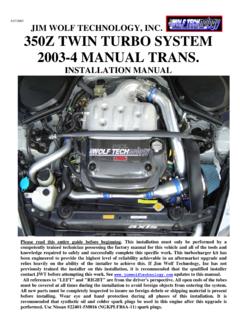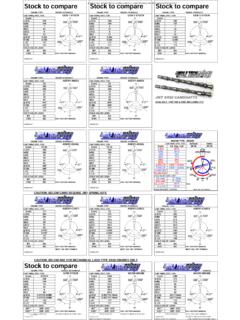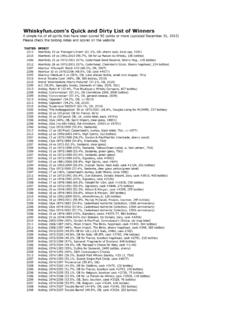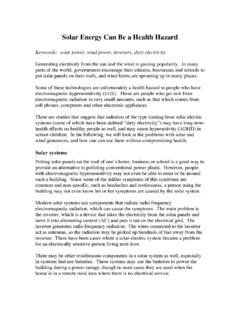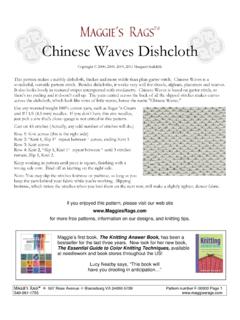Transcription of THE DIRTY LITTLE SECRETS ABOUT CAMSHAFT …
1 Jim Wolf Technology, Inc. 212 Millar Ave. El Cajon, CA 92020 619 442-0680 fax 619 THE DIRTY LITTLE SECRETS ABOUT CAMSHAFT DESIGN EVERY ENGINE BUILDER SHOULD KNOW Jim Wolf Valve motion is probably the least understood element of a successful performance engine. Kinematics, fluid dynamics and metallurgy must all be mastered by any engineer that sets out to design a successful valve motion profile for a high performance engine and ultimately translate this motion onto a CAMSHAFT that will accurately produce the same motion at the valves.
2 This is not always the level of engineering you will get when choosing a CAMSHAFT for your engine. Unfortunately there is a DIRTY LITTLE secret in cam design that is still practiced today by some manufacturers that either don t know what they don t know or choose to ignore the learning curve required to engineer a modern high performance CAMSHAFT . Morphing or master tweaking is when a cam grinder takes an existing profile master (a large lobe shaped disc followed by a cam grinding machine) and tweaks the grinding machine (including CNC grinders) causing it to stretch or distort the actual grinding path of the master to achieve a morphed cam lobe and then builds a second master from the morphed lobe.
3 This is not cam design by any stretch of the imagination, yet many cam grinders unfortunately still use morphing to develop new profiles! Hertzian contact stress, spring harmonics, maximum follower wear path length, component mass and flex, and cam drive feed back are examples of just a few of the constraints that cannot be directly address by morphing. Modern lobe design is no longer primarily done in the displacement domain or physical shape of the lobe, but in the derivatives of that shape. Velocity, Acceleration, and Jerk are the first 3 derivative domains of the lobe shape and are the domains that most of the real design work is accomplished in.
4 Even mechanical engineers can struggle with designing in multiple domains, so it is not the point here to teach but simply to describe the process. The designer must first understand and then solve for the constraints of the specific engine application being addressed, including the intended RPM range, required airflow along with the inherent physical and volumetric weaknesses of the original engine. This process cannot be accomplished with morphing! Another DIRTY LITTLE secret that shouldn t be a big surprise is that when a really great cam hits the market, the same guys that are morphing profiles are busy attempting to copy these cams (and again morph this copy!)
5 It is impossible to accurately reproduce an engineered profile by copying an existing cam. This is like taking an old VHS videotape and trying to digitize it to make an original HD DVD out of it! Yes, the new lobe will be a similar looking lump on a stick yet it can behave completely different in the engine! This is because it is impossible even with a $100K+ Adcole cam-measuring device to reconstruct the original polynomial spline segments or the knot points that blend them together, by measuring an existing lobe.
6 Similar to the VHS to HD DVD analogy, if a CAMSHAFT is copied from an existing lobe, it will not produce the exact valve motion intended by the original design engineer. High performance camshafts should always be produced directly from the original design profile never from a copy or a morph of another cam lobe. Without owning the original design profile data, there can never be any quality control after grinding, as there is nothing available to quantify the finished cam to. This is a real problem for the grinder when checking the Jerk or 3rd derivative of the production cam, as Jerk can get very large in all the wrong places during grinding without the original data to compare.
7 Jerk is basically the rate of change of the rate of change of the Velocity in follower movement per degree and must be measured at .000001 resolution. To explain how Jerk affects motion, suppose you are helping a stranded friend push his car off of the freeway using your own car. If you have your front bumper touching his rear bumper and slowly and Jim Wolf Technology, Inc. 212 Millar Ave. El Cajon, CA 92020 619 442-0680 fax 619 begin to increase speed, you should not damage either cars bumper and would continue to accelerate smoothly to a very high speed without damage.
8 However, if you get a LITTLE nervous on the throttle, the rate of acceleration will become erratic damaging the bumpers as the pressure between the two bumpers starts to vary erratically, this is Jerk. Jerk is the domain that vibration and harmonic problems are typically found and designed out of a cam profile before production proceeds and is checked during manufacturing to insure a true reproduction of the original design. Buried in this simple analogy is the reason that many engine builders continue to add more and more spring pressure when their engine starts experiencing seat bounce and premature valve float.
9 The spring pressure may be correct, but a large amount of unexpected Jerk in the cam profile is causing surge in the spring, which can decrease the effective spring pressure by 30% or more at certain RPMs. A properly designed profile will have the natural frequencies of the spring and all of the harmonics of the profile matched so that spring surge is eliminated in the intended RPM range of the engine. Covering up a bad profile with added spring pressure is a LITTLE like putting lipstick on a pig ! Even a well-designed lobe for one engine can be a disaster in another if all of the constraints of each engine are not considered.
10 For example, an engine family uses a basic lobe on bucket on valve design. The bucket follower is 30mm in diameter, but a later version of the same engine has a 5mm shorter valve stem, placing the bucket follower lower by 5mm with a base circle radius increase of the same 5mm to compensate. If the same performance cam lobe profile is used on the later engine (just scaled up for the larger base circle), the original profile will likely run off the bucket and destroy the cam. A new profile must be designed with a slightly slower peak velocity.


